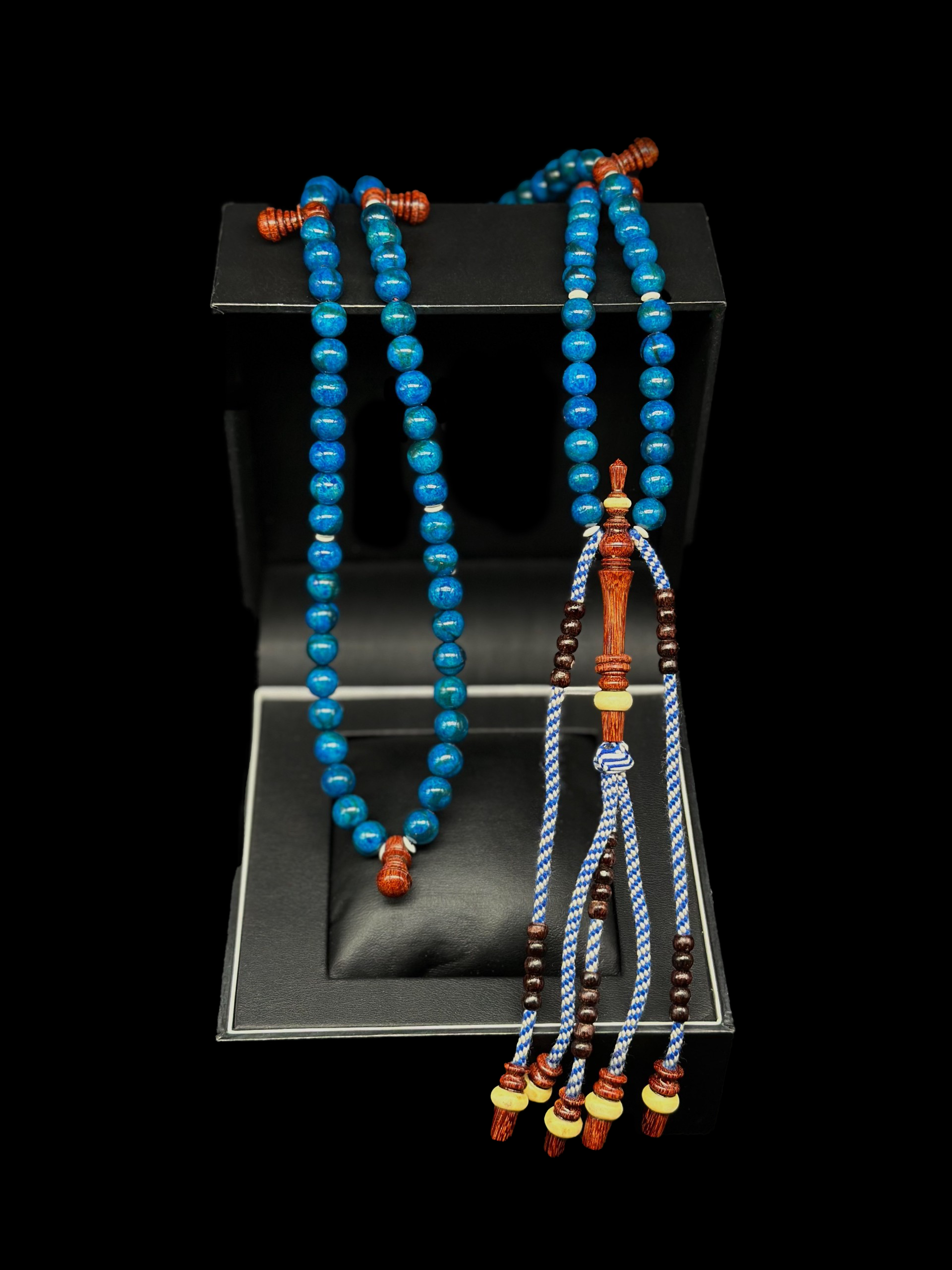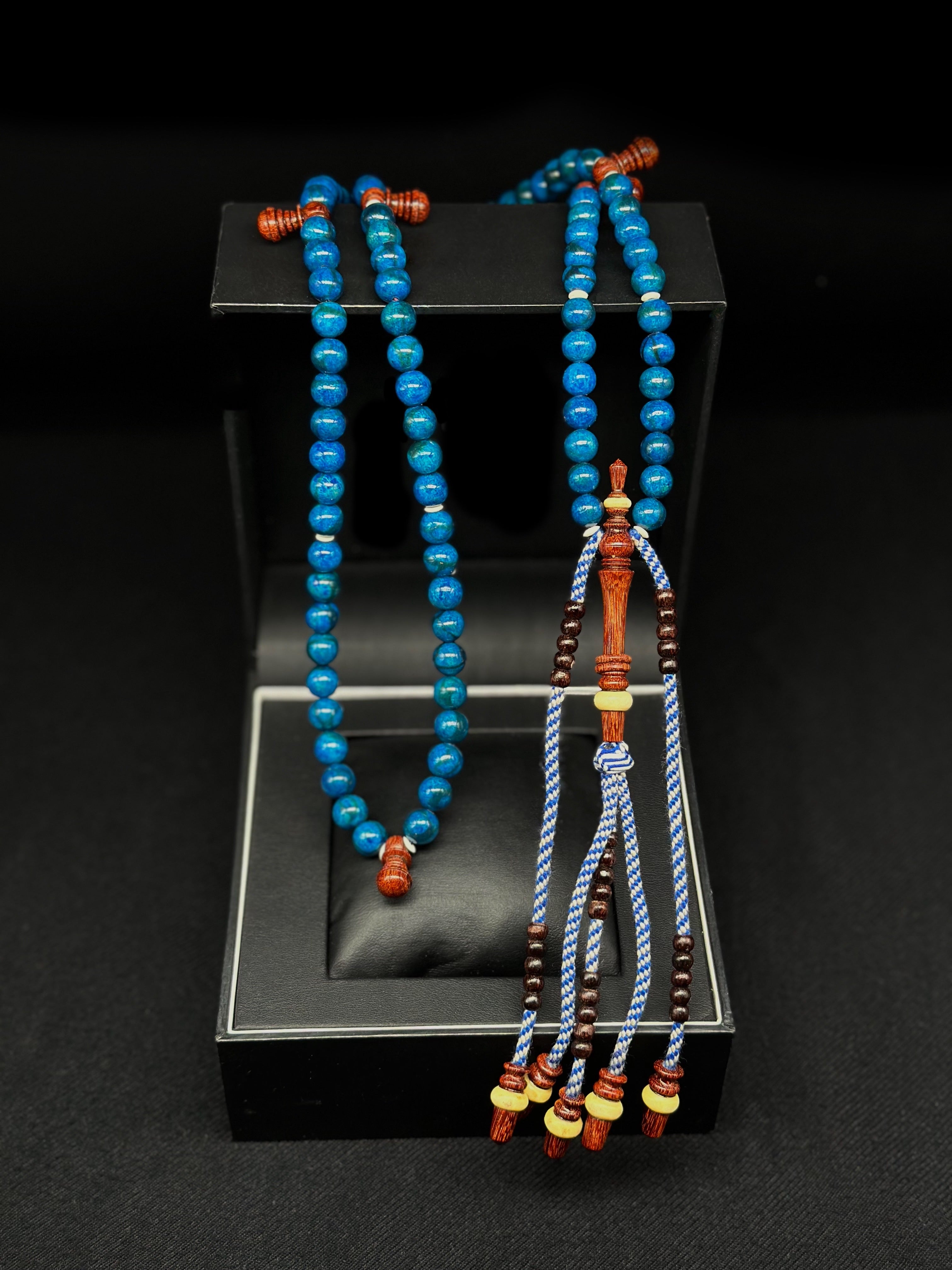

Blue Marjan x Tamarind x Cow Bone Rumi Model Tasbih
The Material
Marjan, a coral formed over millions of years.
خْرُجُ مِنْهُمَا اللُّوْلُوُ وَالْمَرْجَانُ
"There come forth from both of them (the waters) pearls and coral."
— Surah Rahman (55:22)
Origin
The origins of Marjan (coral) trace back to the Holy Qur'an, where it is mentioned as a divine creation of God, residing deep within the oceans. This noble mention in Surah Rahman elevates Marjan beyond its material value, positioning it as a healing gift for mankind. Anything spoken of in the Divine Scriptures carries a profound benefit, and coral is no exception. Throughout history, it has been revered for its spiritual significance and therapeutic properties, making it one of the most precious and sought-after gemstones.
Formation
Coral is formed over millions of years by marine organisms, making each bead a unique, natural work of art, rich in texture and beauty. Its smooth, polished surface enhances its tactile appeal during dhikr (remembrance of Allah), offering a serene and calming feel as one moves their fingers over each bead.
History
The use of coral dates back to Ancient Egypt, where it was crafted into various forms of jewelry and considered an emblem of protection and prosperity. During the first to tenth centuries, coral became a valuable commodity in the trade routes between the Mediterranean and India. Its high price was attributed not only to its beauty but also to the widely held belief that coral possessed sacred and mysterious powers.
Historically, coral was often used for both adornment and protection. People would hang coral stones around their children’s necks, believing it to ward off the evil eye and negative energies. This tradition of using coral for protection still resonates in many cultures today, underscoring its timeless appeal as a guardian stone.
Extra
In addition to its aesthetic value, coral is deeply symbolic. Its association with the oceans, a representation of life, depth, and the unseen mysteries of Allah's creation, resonates with its ability to bring emotional balance and harmony. Many believe that wearing coral strengthens one's connection to the natural world, providing mental clarity and promoting a sense of peace.
Whether as a gemstone for adornment or a spiritual tool, Marjan holds a significant place in the lives of those who revere the Divine and seek the blessings embedded in Allah's creation.
The Craft
Stage 1 – The Design:
The intricate design of the prayer beads are envisioned by the craftsman and a rough outline is sketched out onto a blank canvas. It is at this stage where the craftsman selects which materials they wish to utilise.
Stage 2 – Acquisition of the raw materials:
The hunt for the chosen materials begins and the wood is then ethically sourced and harvested from the finest and 100% organic of materials.
Stage 3 – The resize:
Once the material has been sourced it is then cut into smaller blanks and is now ready to begin onto the next stage of the process.
Stage 4 – The carving:
At this stage the beads, minarets, and separator pieces are carved into the desired shape and pattern. It is important to know that this entire method is done by hand; there are no molds, markers or guidelines. This is a skill and art form which requires exquisite hand co-ordination and takes a craftsman many years to learn and perfect.
Stage 5 – Excavating the holes:
Similar to the last stage this is a skill which requires years of practise. There are no markers or guidelines, and if the holes are off by even a fraction of a millimetre the prayer beads will not be aligned correctly. If the holes are too narrow this will result in the beads being stiff and difficult to move along the thread. If the holes are too wide this will result in the beads being extremely loose and difficult to use.
Stage 6 – Unmasking the natural beauty:
The materials are then sanded to bring out the beauty which is hidden deep within the beads. slowly each and every grain is uncovered and is manifested within each bead.
Stage 7 – The set up:
There are currently 3 main set up systems of how prayer beads are separated;
Shadhili – 100 beads separated using 3 dividers in the set up of 33/17/17/33.
Naqshbandi – 200 beads separated using 7 dividers in the set up of 7/11/40/70
Tijani – 100 beads separated using 5 dividers in the set up of 12/18/20.
Stage 8 – The stringing:
The beads are now finally ready to be stringed together using a durable thread. It is at this stage where the thread tension is decided on and with some can even be adjusted afterwards.
Stage 9 – The tassel:
This process takes hours to complete and is crucial in the overall look and design of the prayer beads.
Stage 10 – The inspection:
The set of prayer beads are now ready for one last inspection before they are to be released.
Specification
Bead Count: 100
Bead Size: 8mm
Material: Marjan
Choose options



